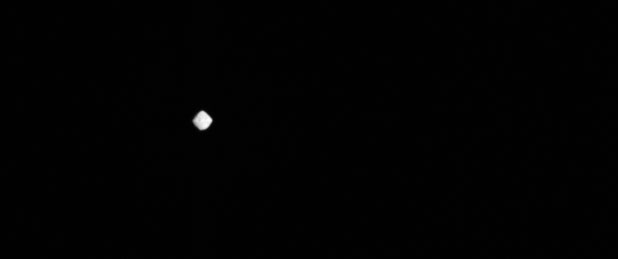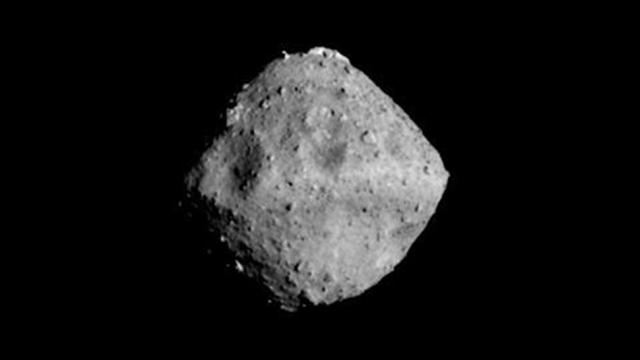The Hayabusa 2 spacecraft’s latest photo of the Ryugu asteroid, taken from a distance of just 40km, shows for the first time surface features such as boulders and craters, in addition to revealing the object’s unique dice-like appearance.
Asteroid Ryugu, seen at a distance of 40km on 24 June 2018. Image: JAXA, University of Tokyo, Kochi University, Rikkyo University, Nagoya University, Chiba Institute of Technology, Meiji University, Aizu University, AIST
Remember the Rosetta spacecraft’s first photos of Comet 67P/Churyumov-Gerasimenko and how it looked like a rubber ducky? We’re now going through a similar phase with Japan’s Hayabusa 2 spacecraft as it gets progressively closer to the Ryugu asteroid, and we’re starting to get the first glimmerings of what this remote object, located 280 million km from Earth, actually looks like.
This new photo of Ryugu, taken by the spacecraft’s ONC-W1 (Optical Navigation Camera – Wide angle) on June 24, reveals an object that appears to have roughly the shape of an eight-sided die – a game piece that players of Dungeons and Dragons are very familiar with. Hayabusa 2 project manager Yuichi Tsuda said it looks like a piece of fluorite, or even an abacus bead.
The new photo also shows craters, rocks and other geographical features, which means project planners can start to think about where the space probe will dispatch its four landers.

Image: JAXA, University of Tokyo, Kochi University, Rikkyo University, Nagoya University, Chiba Institute of Technology, Meiji University, Aizu University, AIST
Launched on 3 December 2014, Hayabusa 2 is now tantalising close to its target. The purpose of the mission is to collect samples of the Ryugu asteroid and then return them to Earth for analysis.
Ryugu is a Type C asteroid, containing traces of water and organic material, and is 870m wide. By analysing the material found on this distant rock, scientists will have a better idea of what the early conditions were like at the time the Solar System formed some 4.6 billion years ago. Hayabusa 2 is expected to return to Earth with its samples in late 2020.
As Tsuda pointed out in a press release, the surprising shape of Ryugu is both good and bad news for the mission.
“First of all, the rotation axis of the asteroid is perpendicular to the orbit,” he said. “This fact increases the degrees of freedom for landing and the rover decent operations. On the other hand, there is a peak in the vicinity of the equator and a number of large craters, which makes the selection of the landing points both interesting and difficult.”
Ryugu’s seemingly octahedron-like shape means the direction of gravitational force on the wide areas of the asteroid will not point directly down; it’s not a perfect sphere. “We therefore need a detailed investigation of these properties to formulate our future operation plans,” said Tsuda.
This latest pic is great, but it’s just the beginning. In addition to Hayabusa 2’s ONC-W1 camera, the landers will also be able to snap pictures. We’re about to get up close and personal with this intriguing celestial object.
[JAXA]
